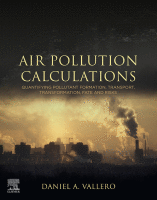Browse content
Table of contents
Actions for selected chapters
- Full text access
- Book chapterAbstract only
Chapter 1 - Introduction
Pages 1-27 - Book chapterAbstract only
Chapter 2 - Characterizing air pollutants
Pages 29-44 - Book chapterAbstract only
Chapter 3 - Pollutant transformation
Pages 45-72 - Book chapterAbstract only
Chapter 4 - Environmental partitioning
Pages 73-105 - Book chapterAbstract only
Chapter 5 - Air partitioning
Pages 107-122 - Book chapterAbstract only
Chapter 6 - Physical transport of air pollutants
Pages 123-143 - Book chapterAbstract only
Chapter 7 - Water and the atmosphere
Pages 145-174 - Book chapterAbstract only
Chapter 8 - Air pollution biogeochemistry
Pages 175-206 - Book chapterAbstract only
Chapter 9 - Thermal reactions
Pages 207-218 - Book chapterAbstract only
Chapter 10 - Air pollution phases and flows
Pages 219-261 - Book chapterAbstract only
Chapter 11 - Sampling and analysis
Pages 263-333 - Book chapterAbstract only
Chapter 12 - Air pollution risk calculations
Pages 335-375 - Book chapterAbstract only
Chapter 13 - Air pollution control technologies
Pages 377-428 - Book chapterAbstract only
Chapter 14 - Air pollution dispersion models
Pages 429-448 - Book chapterAbstract only
Chapter 15 - Economics and project management
Pages 449-471 - Book chapterAbstract only
Chapter 16 - Reliability and failure
Pages 473-487 - Book chapterAbstract only
Chapter 17 - Air pollution decision-making
Pages 489-525 - Book chapterNo access
Appendix 1 - Key equations
Pages 527-534 - Book chapterNo access
Appendix 2 - Abbreviations and symbols
Pages 535-543 - Book chapterNo access
Index
Pages 545-556
About the book
Description
Air Pollution Calculations introduces the equations and formulae that are most important to air pollution, but goes a step further. Most texts lack examples of how these equations and formulae apply to the quantification of real-world scenarios and conditions. The ample example calculations apply to current air quality problems, including emission inventories, risk estimations, biogeochemical cycling assessments, and efficiencies in air pollution control technologies. In addition, the book explains thermodynamics and fluid dynamics in step-by-step and understandable calculations using air quality and multimedia modeling, reliability engineering and engineering economics using practical examples likely to be encountered by scientists, engineers, managers and decision makers. The book touches on the environmental variables, constraints and drivers that can influence pollutant mass, volume and concentrations, which in turn determine toxicity and adverse outcomes caused by air pollution. How the pollutants form, move, partition, transform and find their fate are explained using the entire range of atmospheric phenomena. The control, prevention and mitigation of air pollution are explained based on physical, chemical and biological principles which is crucial to science-based policy and decision-making.
Users will find this to be a comprehensive, single resource that will help them understand air pollution, quantify existing data, and help those whose work is impacted by air pollution.
Air Pollution Calculations introduces the equations and formulae that are most important to air pollution, but goes a step further. Most texts lack examples of how these equations and formulae apply to the quantification of real-world scenarios and conditions. The ample example calculations apply to current air quality problems, including emission inventories, risk estimations, biogeochemical cycling assessments, and efficiencies in air pollution control technologies. In addition, the book explains thermodynamics and fluid dynamics in step-by-step and understandable calculations using air quality and multimedia modeling, reliability engineering and engineering economics using practical examples likely to be encountered by scientists, engineers, managers and decision makers. The book touches on the environmental variables, constraints and drivers that can influence pollutant mass, volume and concentrations, which in turn determine toxicity and adverse outcomes caused by air pollution. How the pollutants form, move, partition, transform and find their fate are explained using the entire range of atmospheric phenomena. The control, prevention and mitigation of air pollution are explained based on physical, chemical and biological principles which is crucial to science-based policy and decision-making.
Users will find this to be a comprehensive, single resource that will help them understand air pollution, quantify existing data, and help those whose work is impacted by air pollution.
Key Features
- Explains air pollution in a comprehensive manner, enabling readers to understand how to measure and assess risks to human populations and ecosystems actually or potentially exposed to air pollutants
- Covers air pollution from a multivariate, systems approach, bringing in atmospheric processes, health impacts, environmental impacts, controls and prevention
- Facilitates an understanding of broad factors, like climate and transport, that influence patterns and change in pollutant concentrations, both spatially and over time
- Explains air pollution in a comprehensive manner, enabling readers to understand how to measure and assess risks to human populations and ecosystems actually or potentially exposed to air pollutants
- Covers air pollution from a multivariate, systems approach, bringing in atmospheric processes, health impacts, environmental impacts, controls and prevention
- Facilitates an understanding of broad factors, like climate and transport, that influence patterns and change in pollutant concentrations, both spatially and over time
Details
ISBN
978-0-12-814934-8
Language
English
Published
2019
Copyright
Copyright © 2019 Elsevier Inc. All rights reserved.
Imprint
Elsevier
